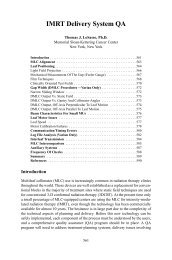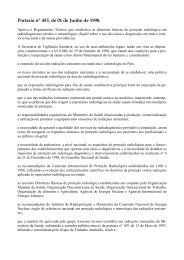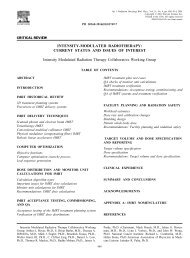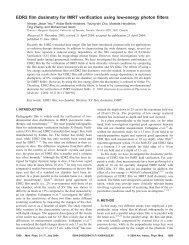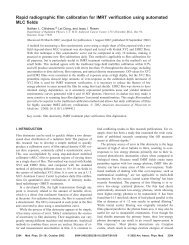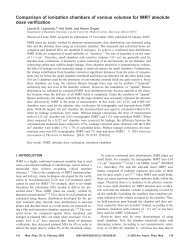Clinical evaluation of monitor unit software and the application of ...
Clinical evaluation of monitor unit software and the application of ...
Clinical evaluation of monitor unit software and the application of ...
Create successful ePaper yourself
Turn your PDF publications into a flip-book with our unique Google optimized e-Paper software.
Table 1<br />
Overview <strong>of</strong> institutions <strong>and</strong> <strong>the</strong> respective radio<strong>the</strong>rapy equipment for clinical testing <strong>and</strong> <strong>evaluation</strong> <strong>of</strong> <strong>the</strong> independent dose verification<br />
s<strong>of</strong>tware ‘MUV’<br />
Radio<strong>the</strong>rapy institution TPS <strong>and</strong> applied algorithm Linacs Energies (MV)<br />
University Umea˚ Helax TMS (V6.1) pencil beam or collapsed cone a<br />
Siemens Primus 6/18<br />
Medical University Vienna Helax TMS (V6.1) pencil beam or collapsed cone a<br />
ELEKTA Precise 6/10/25<br />
GE SAT 43 6/10/25<br />
Medical University Graz Pinnacle (V6.2b) superposition Varian Clinac 2300 CD 6/18<br />
University Basel XiO (V4.2) convolution/superposition ELEKTA Precise 6/18<br />
University Copenhagen Eclipse (V7.3.10) pencil beam Varian Clinac 2300 EX 6/18<br />
a<br />
...applied for lung treatments only.<br />
Results were acquired for 226 individual treatment plans<br />
including a total <strong>of</strong> 815 radiation fields. Table 2 gives an<br />
overview <strong>of</strong> <strong>the</strong> considered cases as a function <strong>of</strong> treatment<br />
technique <strong>and</strong> treatment area. All different treatment techniques,<br />
ranging from regular <strong>and</strong> irregular open fields to<br />
wedged fields using a physical or dynamic wedge, <strong>and</strong> dynamic<br />
as well as step-<strong>and</strong>-shoot IMRT could be h<strong>and</strong>led with<br />
MUV <strong>and</strong> were included in this study.<br />
The accuracy <strong>of</strong> MUV against measurements, performed<br />
in a homogeneous water phantom, has been demonstrated<br />
during <strong>the</strong> design <strong>and</strong> pre-clinical testing phase [17–20].<br />
For example, for irregular MLC shaped fields a st<strong>and</strong>ard<br />
deviation <strong>of</strong> 0.47% was obtained between calculated <strong>and</strong><br />
measured output factors (in water or air) for about 300 test<br />
Table 2<br />
Summary <strong>of</strong> treatment fields, treatment techniques, treatment<br />
sites, etc., for clinical testing <strong>of</strong> <strong>the</strong> independent dose verification<br />
s<strong>of</strong>tware ‘MUV’<br />
Treatment area # <strong>of</strong> plans # <strong>of</strong> fields Techniques<br />
Pelvis 98 364 Open 273<br />
Physical wedge 46<br />
Dynamic wedge 38<br />
Step-shoot IMRT 0<br />
Dynamic IMRT 7<br />
Thorax 46 155 Open 95<br />
Physical wedge 17<br />
Dynamic wedge 36<br />
Step-shoot IMRT 7<br />
Dynamic IMRT 0<br />
Head-<strong>and</strong>-neck 71 271 Open 75<br />
Physical wedge 48<br />
Dynamic wedge 22<br />
Step-shoot IMRT 63<br />
Dynamic IMRT 63<br />
O<strong>the</strong>r 11 25 Open 3<br />
Physical wedge 20<br />
Dynamic wedge 2<br />
Step-shoot IMRT 0<br />
Dynamic IMRT 0<br />
Total 226 815 Open 446<br />
Physical wedge 131<br />
Dynamic wedge 98<br />
Step-shoot IMRT 70<br />
Dynamic IMRT 70<br />
D. Georg et al. / Radio<strong>the</strong>rapy <strong>and</strong> Oncology 85 (2007) 306–315 309<br />
cases, where 5, 10, <strong>and</strong> 20 cm depth were considered toge<strong>the</strong>r<br />
with four different MLC designs. Maximum deviations<br />
did not exceed 1.7%, even for <strong>the</strong> most irregular field shapes<br />
[20]. Therefore, <strong>the</strong> main focus <strong>of</strong> this study was <strong>the</strong> clinical<br />
<strong>application</strong> <strong>of</strong> <strong>the</strong> independent MUV s<strong>of</strong>tware. However,<br />
verification measurements were also performed for a small<br />
number <strong>of</strong> individual treatment plans encompassing in total<br />
150 beams. Of <strong>the</strong>se more than 100 beams with segmentally<br />
modulated fluence patterns (dynamic wedges <strong>and</strong> IMRT)<br />
were specifically tested as <strong>the</strong>y were not considered in detail<br />
in previous tests.<br />
Finally, all observed deviations between MUV <strong>and</strong> <strong>the</strong> different<br />
TPSs were analysed in order to assess <strong>the</strong> clinical<br />
<strong>application</strong> <strong>of</strong> realistic action levels (AL). For that purpose<br />
current results <strong>and</strong> previously performed experimental<br />
benchmarking tests <strong>of</strong> <strong>the</strong> algorithm implemented in MUV<br />
were combined [17–20].<br />
Results<br />
In general good overall agreement was found between<br />
calculations performed with <strong>the</strong> different TPS <strong>and</strong> MUV calculations,<br />
with a mean deviation per field <strong>of</strong> 0.2 ± 3.5%<br />
(1 SD), <strong>and</strong> mean deviations <strong>of</strong> 0.2 ± 2.2% for a composite<br />
treatment. For a more detailed analysis all treatments<br />
<strong>and</strong>/or fields were binned with respect to treatment area,<br />
treatment technique, <strong>and</strong> <strong>the</strong> use <strong>of</strong> geometrical depth or<br />
radiological depth, respectively.<br />
Treatment site specific deviations<br />
Fig. 1a <strong>and</strong> b present <strong>the</strong> fraction <strong>of</strong> beams with deviations<br />
between <strong>the</strong> local TPS <strong>and</strong> MUV that are exceeding a<br />
certain limit, separated for treatment site (pelvis, thorax,<br />
head-<strong>and</strong>-neck, o<strong>the</strong>r) <strong>and</strong> whe<strong>the</strong>r any depth corrections<br />
were performed. While for pelvic treatments less than 10%<br />
<strong>of</strong> all fields showed deviations larger than 3%, irrespective<br />
<strong>of</strong> radiological depth corrections, this fraction was almost<br />
40% for thorax fields <strong>and</strong> 30% for head-<strong>and</strong>-neck fields.<br />
When using <strong>the</strong> radiological depth, <strong>the</strong> fraction <strong>of</strong> beams<br />
with deviations larger than 3% could be reduced to about<br />
10% for head-<strong>and</strong>-neck <strong>and</strong> to 30% for thorax treatments.<br />
For <strong>the</strong> latter <strong>application</strong> an agreement between TPS <strong>and</strong><br />
MUV calculations for about 90% <strong>of</strong> all fields could be<br />
achieved only at <strong>the</strong> 4.5% deviation level (when applying<br />
<strong>the</strong> radiological depth).




